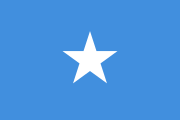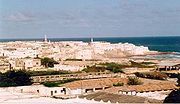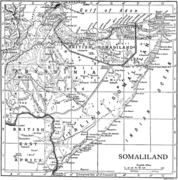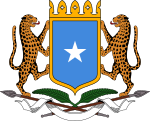|
Camels on sale at Baidoa livestock market in Somalia on November 7, 2019
Somalia, officially the Federal Republic of Somalia is a country located in the Horn of Africa. It is bordered by Ethiopia to the west, Djibouti to the northwest, the Gulf of Aden to the north, the Indian Ocean to the east, and Kenya to the southwest. Somalia has the longest coastline on the mainland of Africa, with a seaboard that stretches 3,025 kilometres (1,880 mi). In antiquity, Somalia was an important centre for commerce with the rest of the ancient world, it is among the most probable locations of the fabled ancient Land of Punt. During the Middle Ages, several powerful Somali empires dominated the regional trade, including the Ajuuraan Sultanate, the Adal Sultanate and the Geledi Sultanate. In the late nineteenth century, through a succession of treaties with these kingdoms, the British and Italians gained control of parts of the coast, and established British Somaliland and Italian Somaliland. In the interior, the Dervish State wherein Muhammad Abdullah Hassan was leader successfully repulsed the British Empire four times and forced it to retreat to the coastal region. Italian occupation lasted until 1941, yielding to British military administration. British Somaliland would remain a protectorate, while Italian Somaliland in 1949 became a United Nations Trusteeship under Italian administration, the Trust Territory of Somaliland. Though, in 1960, the two regions united to form the independent Somali Republic under a civilian government. In 1991, following the collapse of the government of Siad Barre, the Republic of Somaliland unilaterally declared its independence from Somalia, reinstating the borders of former British Somaliland, and has been governed by democratically elected leaders since. Somaliland's independence, however, has not been recognised by any foreign country or international organisation. Somalia has a population of around 10 million. About 85% of local residents are ethnic Somalis, Somali and Arabic are the official languages of Somalia, both of which belong to the Afro-Asiatic family. Most people in the territory are Muslims, the majority being Sunni.  Puntland (Somali: Puntland, Arabic: أرض البنط, Italian: Terra di Punt or Paese di Punt), officially the Puntland State of Somalia (Somali: Dowlad Goboleedka Puntland ee Soomaaliya, Arabic: ولاية أرض البنط الصومالية), is an autonomous territory formed in 1998 that became a Federal Member State. Puntland is located in the northeastern part of Somalia and its state capital is the city of Garoowe in the Nugal region. The region had a population of 4,334,633 in 2016. Geographically to the west, Puntland lays claim to the intra-46th meridian territories that were outside European colonial rule during parts of the Scramble for Africa period. Puntland is bordered by Somaliland to its west, the Gulf of Aden in the north, the Guardafui Channel in the northeast, the Indian Ocean in the southeast, the central Galmudug region in the south, and Ethiopia in the southwest. There are several major geographical apexes in Puntland, including the Cape Guardafui, which forms the tip of the Horn of Africa, Ras Hafun the easternmost place on the entire African continent, and the beginning of the Karkaar mountain range. It also has the northernmost major city in Somalia, Bosaso, located at a line of latitude higher than 11° north. (Full article...) This is a Good article, an article that meets a core set of high editorial standards.
The Embassy of the United States of America to Somalia is a diplomatic mission of the United States in Mogadishu, Somalia from 1960 to 1991. In 1957, the US opened a consulate-general in Mogadishu—the capital of the Trust Territory of Somalia, a UN trusteeship under Italian administration. The consulate was upgraded to embassy status in July 1960, when the US recognized Somalia's independence and appointed an ambassador. The embassy served to counter Soviet influence during the Cold War and also served as a base for the United States Agency for International Development, which had a large presence in the country. In 1989, the embassy moved from a dilapidated building in central Mogadishu to a new compound on the outskirts of the city. Violence quickly enveloped the city in late December 1990, during the Somali Civil War, and on 1 January 1991, the ambassador contacted the State Department to request the closure and evacuation of the embassy. Approval was given the following day, but violence and the collapse of the central government prevented the US, and several other countries, from airlifting their diplomats and civilians through Mogadishu International Airport. USS Guam and USS Trenton, which were stationed off the coast of Oman, were dispatched to airlift staff from the embassy; American civilians and many foreign diplomats also gathered at the embassy, seeking evacuation. The embassy closed on January 5, 1991, and 281 American and foreign diplomats and civilians were airlifted by helicopter from the embassy compound to Guam and Trenton. (Full article...)

The following are images from various Somalia-related articles on Wikipedia.
The following Wikimedia Foundation sister projects provide more on this subject:

Sources for additional Somalia news
Discover Wikipedia using portals | |||||||||||||||

































































































